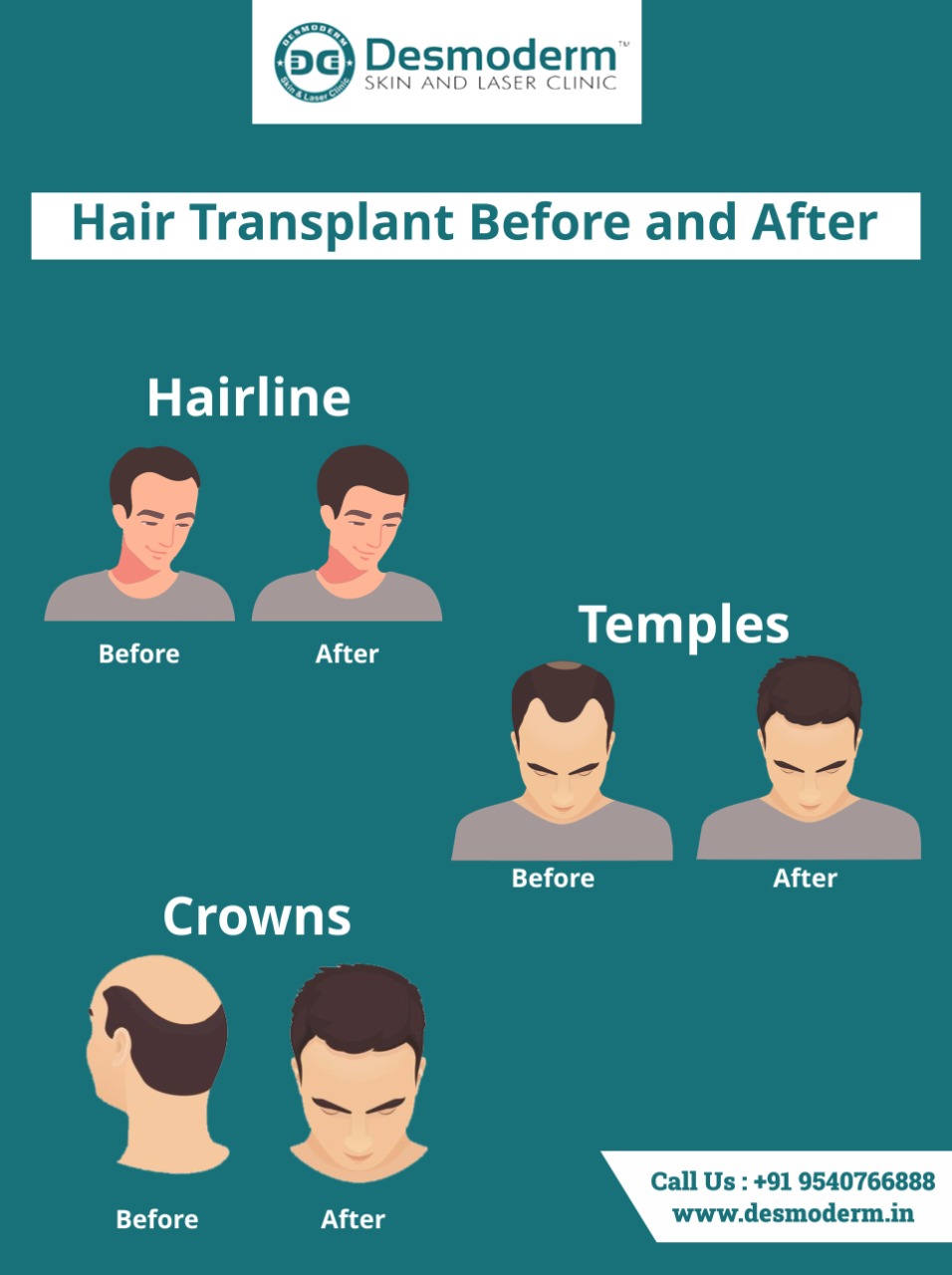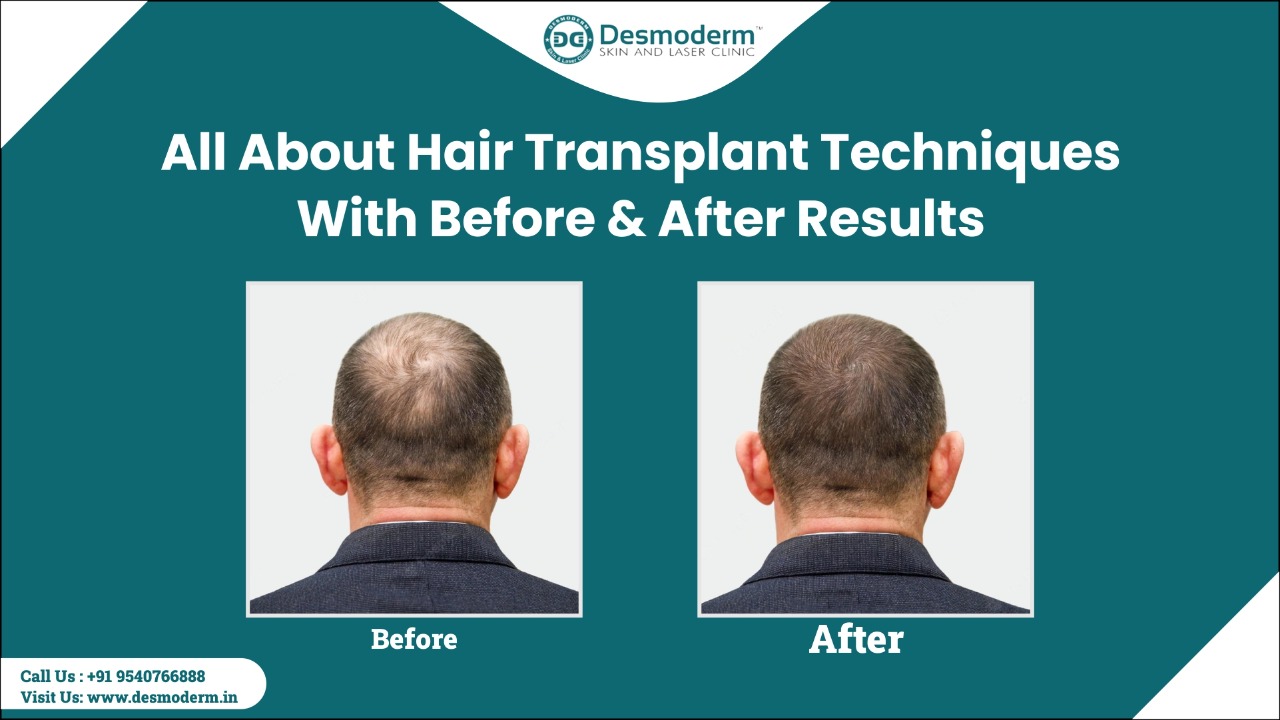Hair transplant is one of the best hair restoration treatments for those suffering from baldness. When we look at before and after hair transplant pictures of different people online, they convey the effectiveness of the procedure in bringing a change in their appearance. It is one of the most effective near permanent modality for hair regrowth currently available for baldness by implanting the patient’s own hair grafts in the target area of the scalp. The hair transplant is designed differently for each patient depending upon the degree of hair fall, bald area to be covered, and the number of grafts available in the donor area of the scalp.
Table of Contents:-
- What Do You Need To Know Before Hair Transplant?
- Hair Transplant Procedure
- What to Expect Just After Hair Transplant
- Hair transplant: the outcome timeline
- Takeaway
What do you need to know before a hair transplant?
Nowadays, hair transplant has become an increasingly popular treatment amongst men suffering from alopecia areata or baldness due to physiological and environmental conditions. If you are experiencing massive hair fall and are gradually progressing towards baldness, you may be considering a hair transplant to regrow your hair. But, there are certain things you should know before scheduling an appointment with a hair transplant surgeon-
When should I get a hair transplant done?
We first need to be sure about the cause and progression of hair loss. In case you are experiencing severe hair loss which is more than 100 hair per day for more than 2-4 weeks better to consult dermatologist and rule out the cause for it . Hair transplant is reserved for cases where there is no hair follicle on the scalp ( bald patch) and loss is stabilised . Certain preventive measures such as peptide based lotions, PRP/ GFC therapy can be initiated to stabilise the hair loss process.
Is hair transplant permanent?
Of course! The transplanted hairs will grow thick and fuller for life, giving impressive yield to cover bald patches. You have a choice to pick from the FUT or FUE technique, depending on the number of donor hair grafts available in the donor area.
Is the procedure painful?
Hair transplant is a surgical procedure. Hence a little discomfort is expected. You may be prescribed pain-relievers and antibiotics to lower discomfort and prevent infections.
Who is a good candidate for hair transplant?
A good candidate for hair transplant is someone experiencing high-grade baldness but has ample donor hair at the back of the scalp. Besides, your commitment to pre and post-operative care makes you an ideal candidate for hair transplant.
Types of hair transplant procedures
There are two types of hair transplant procedures- Follicular Unit Transplant (FUT) and Follicular Unit Extraction (FUE). The FUT technique is said to be more conventional approach as it has some side effects like scar on the donor area, slow healing and more post operative discomfort on the donor area. Let’s understand both of them in detail.
Follicular Unit Transplant (FUT) – It is the conventional method of hair transplant in which a cosmetic surgeon would extract a 1-1.5 cms wide strip of donor’s hair starting from ear to ear at the back of your head. The incision made is closed using a trichophytic closure method to minimize the appearance of the scar. After that, your hair restoration team members would work to separate the grafts from the extracted strip. These follicles are then seeded back into the bald area of the scalp precisely to develop an aesthetically pleasing hairline.
Follicular Unit Extraction (FUE) – It is the more preferred and advanced technique of hair transplant also preferred by us . This method does not involve the removal of a hair strip from the donor area. The donor grafts are picked individually using a hand-held device with a motorized rotator. After that, the extracted donor hairs are checked and transplanted to the bald area of the scalp. This technique is advanced and doesn’t require strip extraction hence no scar on the back , healing is much faster and less discomfort.
-
Hair transplant: step-by-step
The hair transplant surgery is performed under local anesthesia and may take around 4 to 8 hours. The surgical procedure involves various steps as follows-
- First, your surgeon would design the hairline using a marker, marking the donor area for graft extraction.
- You will be given a sedative or local anesthesia to relieve pain and discomfort during or after the procedure.
- Now, the surgeon would extract individual hair follicles with a 0.7 or 0.8 mm punch.
- A member from the hair restoration team will separate the grafts and prepare them for transplantation.
- The extracted grafts will be precisely re-inserted into your scalp, and an antibiotic will be applied to prevent infections.
- In the FUE method, there is no donor strip extraction involved, and the grafts will be picked individually from the donor area using a hand-held device with a motorized rotator.

What to expect soon after the hair transplant?
Like any surgical procedure, you may feel a bit dizzy due to the sedatives or anesthesia given during the procedure. So, you must take someone along to drive you home safely. Besides, your scalp may feel sore, itchy, and irritated. But, you must refrain from touching your scalp or rubbing it. You may need to wear a breathable cap or bandages for a couple of days after the treatment.
Hair transplant: the outcome timeline
You may be restless and excited to see the new hair growth soon after the hair transplant. But, it may take around 10-12 months to get the best results after getting the treatment. Here is a timeline chart to help you get a fair idea of hair growth month-wise after getting a hair transplant-
Day 1– Do not touch or rub the scalp and cover the head with a breathable cap while going out.
Day 2 -4– Do not touch, itch, or scrap the scabs around the transplanted grafts.
Day 5-7– Take a head bath using a mild, medicated shampoo. You may leave the shampoo on the treated area for longer to soften the scabs.
Week 2-4– The follicles by this time, the hair follicles enter the resting phase, and you will temporarily lose hair shafts. Don’t worry! The roots or bulbs are still there on your scalp.
Month 2-3– Consult your doctor and follow prescription medicines.
Month 6-12- Since the transplanted hairs have become thicker and there are no more baby hairs, you can now style them as per your choice.
Month 12-18- Congratulations! You now have a fuller, thicker, and aesthetically pleasing hairline once again.
Takeaway:-
Hair loss can affect men and women of all ages and ethnicities. The precursors to baldness may be many, ranging from poor lifestyle and stress to genetics. Hair transplant –FUE is a minimally invasive hair restoration treatment. Desmoderm skin and hair care clinic in New Delhi is one of the best places to get hair restoration treatments. Our team of experienced doctors and transplant experts perform these hair transplant treatments using advanced equipment in a state-of-the-art clinic at a reasonable price.
Read More:-
- PRP For Hair Loss
- Thing Considering While Choosing Hair Transplant Surgeon
- Hair Transplant Myths And Facts
- Pre And Post Hair Transplant Care
- Hair Transplant Procedure Recovery Cost
- Fue Hair Transplant Procedure Benefits Recovery Cost
- PRP Hair Treatment Success rate does it Work For Hair Loss
- Before And After Hair Transplant Step by Step Situations
- Hair Transplant
- Pain After Hair Transplant
- Why People Choosing HIFU Treatment Over Botox Filler


